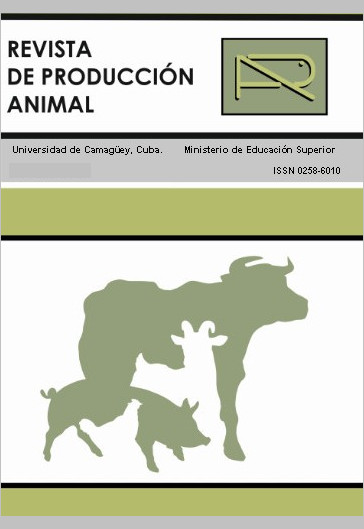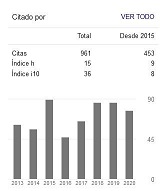Tamaño del folículo ovulatorio, cuerpo lúteo y progesterona sanguínea en vaquillas receptoras de embriones de tres razas en pastoreo en Ecuador.
Resumen
El objetivo del trabajo fue determinar el tamaño del folículo preovulatorio del cuerpo lúteo y los niveles de progesterona sanguínea en los días 6 y 12 post-ovulación en vaquillas de las razas Holstein, Brown Swiss y Criolla criadas en pastoreo en el Altiplano Ecuatoriano. Se determinó el tamaño del folículo preovulatorio, del cuerpo lúteo y los niveles sanguíneos de progesterona en los días 6 y 12 post-ovulación en nueve vaquillas de cada raza. La valoración de las estructuras ováricas se realizó mediante ultrasonografía. La concentración de progesterona sanguínea se determi-nó con el método de electroquimio-luminiscencia. Se estableció que el tamaño del folículo preovulatorio de las vaquillas Criolla fue más grande (14,6 ± 0,41 mm) que el de las Holstein (12,7 ± 0,47 mm) y Brown Swiss (12,7 ± 0,65 mm). La concentración de progesterona en los días 6 y 12 post-ovulación en las vaquillas Criolla (11,0 ±1,68 ng/ml y 18,4 ± 2,04 ng/ml, respectivamente) fue más elevada que el de las Holstein y Brown Swiss. Se observa-ron valores de asociación lineal altos y significativos (P < 0,05), entre el folículo preovulatorio; cuerpo lúteo y progesterona en las Holstein y Brown Swiss y se demostró que por cada milímetro de tamaño adicional sobre la media del Criolla del día 6, se generaría 1,67 ng/ml más de progesterona en las vaquillas Criolla (P < 0,05) que en las dos
restantes. Se concluye que las vaquillas Criolla presentaron mayores niveles de progesterona en los días 6 y 12 post-ovulación en comparación con las razas Holstein y Brown Swiss, lo que generaría un mejor ambiente uterino y, por
consiguiente, menores pérdidas embrionarias tempranas.
Size of Ovulation Follicle and Corpus Luteum, and Blood Progesterone in Heifers Receiving Em-bryos from Three Cattle Breeds Grazing, in Ecuador.
ABSTRACT
The aim of this paper was to determine the size of the pre-ovulation follicle in the corpus luteum, and in blood
progesterone on the sixth and twelfth days after ovulation, in Holstein, Brown, Swiss and Criolla breeds grazing on Ecuadoran Highlands. The size of the pre ovulation follicle and corpus luteum, and the levels of blood progesterone were determined on days sixth and twelfth, in nine heifers from each breed. Assessment of ovarian structures was made by ultrasound scanning. The concentration of blood progesterone was determined by electrochemilumines-cence. The pre ovulation follicle in Criolla heifers was larger (14.6 ± 0.41 mm) than in Holstein (12.7 ±0.47 mm), and in Brown Swiss (12.7 ± 0.65 mm). Progesterone concentration on days six and twelve after ovulation of Criolla heifers (11.0 ± 1.68 ng/ml, and 18.4 ± 2.04 ng/ml, respectively) was higher than for Holstein and Brown Swiss. The linear association values were high and significant (P < 0.05), in the pre ovulati on follicle, corpus luteum and proges-terone, in Holstein and Brown Swiss. It was demonstrated that for every additional millimeter above the Criolla mean on the sixth day, 1.67 ng/ml more of progesterone was generated in Criolla heifers (P < 0.05) than in the rest. It was concluded that the Criolla heifers had higher progesterone levels than Holstein and Brown Swiss on the sixth and twelfth days, thus producing better conditions in the uterus and lower early embryo losses.
Descargas
Citas
ARAÚJO, M. C.; VALE, V. R.; FERREIRA, A. M.; Sá, W. F.; BARRETO FILHO, J. B.; CAMARGO, L. S. y SILVA, M. V. (2005). Secreção de interferontau em embriões bovinos produzidos in vitro frescos e congelados. Arquivo Brasileiro de Medicina
Veterinária e Zootecnia, 57 (6), 751-756.
BARUSELLI, P. S.; DE SÁ Filho, M. F.; MARTINS, C. M.; REIS, E. L. y NASSER, L. F. (2005). Nuevos avances en los tratamientos de SOV en donadoras de embriones bovinos. Congreso internacional de reproducción bovina INTERVET, Bogotá, Colombia.
BRIDGES, P. J.; WRIGHT, D. J.; BUFORD, W. I.; AHMAD, N.; HERNANDEZ-FONSECA, H.; MCCORMICK, M. L. et al. (2000). Ability of In-duced Corpora Lutea to Maintain Pregnancy in
Beef Cows. Journal of Animal Science, 78 (11), 2942-2949.
BROOKS, K.; BURNS, G. y SPENCER, T. E. (2014). Conceptus Elongation in Ruminants: Roles of Progesterone, Prostaglandin, Interferon Tau and Cortisol. Journal of Animal Science and Biotechnology, 5 (1), 1-12.
CHABBERT-BUFFETA, N.; SKINNER, D. C.; CARATY, A. y BOUCHARD, P. (2000). Neuroendocrine Effects of Progesterone. Steroids, 65 (10), 613-620.
CHACÓN JARAMILLO, L.; VARGAS RONCANCIO, M.; OTERO, R. y VILLAMIL, A. (2005). Seguimiento de la dinámica del ovario por ultrasonografía en novillas de la raza Gir. U.D.C.A Actualidad y Divulgación Científica, 8 (2), 103-110.
CHASOMBAT, J.; NAGAI, T.; PARNPAI, R. y VONGPRALUB, T. (2014).Ovarian Follicular Dynamics and Hormones Throughout the Estrous Cycle in Thai Native (Bos indicus) Heifers. Animal
Science Journal, 85 (1), 15-24.
DISKIN, M. G.; KENNY, D. A.; DUNNE, L. Y SREENAN, J. M. (2002). Systemic Progesterone Pre and Post AI And Early Embryo Survival in Cattle. Proceeding of the Agricultural Research Forum. Tullamore,Ireland.
ECHTERNKAMP, S. E.; CUSHMAN, R. A. y ALLAN, M. F. (2009). Size of Ovulatory Follicles in Cattle Ex-pressing Multiple Ovulations Naturally and its In-fluence on Corpus Luteum Development and Fertility. Journal of animal science, 87 (11), 56-68.
EDMONSON, A. J.; LEAN, I. J.; WEAVER, L. D.; FARVER, T. y WEBSTER, G. (1989). A Body Condition Scoring Chart for Holstein Dairy Cows. Jour-nal of dairy science, 72 (1), 68-78.
FAO (2015). Segundo informe sobre la situación de los recursos zoogenéticos mundiales para la alimentación y la agricultura. Roma, Italia: FAO.
FORDE, N.; BAZER, F. W.; SPENCER, T. E. y LONERGAN, P. (2015). Conceptualizing the Endometrium: Identification of Conceptus-Derived Proteins During Early Pregnancy in Cattle 1. Biology of Reproduction, 92 (6), 152-156.
FORDE, N.; BAZER, F. W.; SPENCER, T. E. y LONERGAN, P. (2015). Conceptualizing the Endometrium: Identification of Conceptus-Derived Proteins During Early Pregnancy in Cattle. Biology of reproduction, 92 (6), 156-160.
GINTHER, O. J.; BEG, M. A.; BERGFELT, D. R.; DONADEU, F. X. y KOT, K. (2001). Follicle Selection in Monovular Species. Biology of Reproduc-tion, 65 (3), 638-647.
GONELLA, A. G. (2010). Ambiente receptivo uterino: control materno, control embrionario, muerte embrionaria. Rev. MVZ Córdoba, 15 (1), 1976-1984.
HERZOG, K.; BROCKHAN-LÜDEMANN, M.; KASKE, M.; BEINDORFF, N.; PAUL, V.; NIEMANN, H. y BOLLWEIN, H. (2010). Luteal Blood Flow is a More Appropriate Indicator for Luteal Function During the Bovine Estrous Cycle than Luteal Size. Theriogenology, 73 (5), 691-697.
IRELAND, J. J.; MIHM, M.; AUSTIN, E.; DISKIN, M. G. y ROCHE, J. F. (2000). Historical Perspective of Turnover of Dominant Follicles during the Bovine Estrous Cycle: Key Concepts, Studies, Advancements and Terms. Journal Dairy Science,
83 (7), 1648-1658.
KENYON, A. G.; MENDONÇA, L. G. D.; LOPES, G.; LIMA, J. R.; SANTOS, J. E. P. y CHEBEL, R. C. (2013). Minimal Progesterone Concentration Required for Embryo Survival after Embryo Transfer in Lactating Holstein Cows. Animal reproduction science, 136 (4), 223-230.
LONERGAN, P.; FAIR, T.; FORDE, N. y RIZOS, D. (2016). Embryo Development in Dairy Cattle. Theriogenology, 86 (1), 270-277.
MANN, G. E. (2009). Corpus Luteum Size and Plasma Progesterone Concentration in Cows. Animal reproduction science, 115 (1), 296-299.
MCNEILL, R. E.; DISKIN, M. G.; SREENAN, J. M. y MORRIS, D. G. (2006). Associations Between Milk Progesterone Concentration on Different Days and with Embryo Survival During the Early Luteal Phase in Dairy Cows. Theriogenology, 65 (7), 1435-1441.
OIE (2016). Código sanitario para los animales terrestres. Recuperado el 21 de enero de 2016, de http://www.oie.int/es/normas-internacionales/codigo-terrestre.
PEREA, F.; GONZÁLEZ, R.; CRUZ, R.; SOTO, E.; RINCÓN, E.; GONZÁLEZ, C. y VILLAMEDIANA, P. (1998). Evaluación ultrasonográfica de la dinámica folicular en vacas y en novillas mestizas. Revista Científica FCV-LUZ, 8 (1), 14-24.
PERRY, G. A.; SMITH, M. F.; LUCY, M. C.; GREEN, J. A.; PARKS, T. E.; MACNEIL, M. D. y GEARY, T. W. (2005). Relationship Between Follicle Size at Insemination and Pregnancy Success. Proceedings of the National Academy of Sciences of the United
States of America, 102 (14), 5268-5273.
PIERSON, R. A. y GINTHER, O. J. (1984). Ultrasonography of the Bovine Ovary. Theriogenology, 21 (3), 495-504.
PRIMO, A. T. (1992). El ganado bovino ibérico en las Américas: 500 años después. Archivos de zootecnia, 41 (154), 421-432.
QUEZADA-CASASOLA, A., AVENDAÑO-REYES, L., RAMÍREZ-GODÍNEZ, J. A., MACÍAS-CRUZ, U. y CORREA-CALDERÓN, A. (2014). Behavioural, Follicular and Hormonal Characteristics of the Oestrous Cycle of Mexican Criollo Cattle. Animal Production Science, 54 (3), 277-284.
ROELOFS, J.; LÓPEZ-GATIUS, F.; HUNTER, R. H. F.; VAN EERDENBURG, C. M. y HANZEN, C. (2010). When is a Cow in Estrus? Clinical and Practical Aspects. Theriogenology, 74 (3), 327-344.
SARTORI, R.; HAUGHIAN, J. M.; SHAVER, R. D.; ROSA,
G. J. M. y WILTBANK, M. C. (2004). Comparison of Ovarian Function and Circulating Steroids in Estrous Cycles of Holstein Heifers and Lactating Cows. Journal of dairy science, 87 (4), 905-920.
SAVIO, J. D.; BOLAND, M. P. y ROCHE, J. F. (1990).
Development of Dominant Follicles and Length of Ovarian Cycles in Post-partum Dairy Cows. Journal of Reproduction and Fertility, 88 (2), 581-591.
THATCHER, W. S. D. (1994). Embryo Health and Mortality in Sheep and Cattle. Journal Animal Science, 72 (3), 16-30.
SIROIS, J. y FORTUNE, J. E. (1988). Ovarian Follicular Dynamics During the Estrous Cycle in Heifers Monitored by Real-time Ultrasonography. Biology of reproduction, 39 (2), 308-317.
VASCONCELOS, J. L. M.; SARTORI, R.; OLIVEIRA, H. N.; GUENTHER, J. G. y WILTBANK, M. C. (2001). Reduction in Size of the Ovulatory Follicle Reduces Subsequent Luteal Size and Pregnancy Rate. Theriogenology, 56 (2), 307-314.
WALSH, S. W.; WILLIAMS, E. J. y EVANS, A. C. O. (2011). A Review of the Causes of Poor Fertility in High Milk Producing Dairy Cows. Animal reproduction science, 123 (3), 127-138.
Los autores de los artículos publicados en RPA retienen los derechos de autor de su trabajo, de marca y patente, y también sobre cualquier proceso o procedimiento descrito en el artículo, así como a compartir, copiar, distribuir, ejecutar y comunicar públicamente el artículo publicado en la RPA o cualquier parte de aquel siempre que indiquen la fuente de publicación (autores del trabajo, revista, volumen, número y fecha), pero están de acuerdo en que la revista publique los trabajos bajo una licencia Creative Commons.
![]() Licencia Attribution-NonCommercial 4.0 International (CC BY-NC 4.0)
Licencia Attribution-NonCommercial 4.0 International (CC BY-NC 4.0)






































